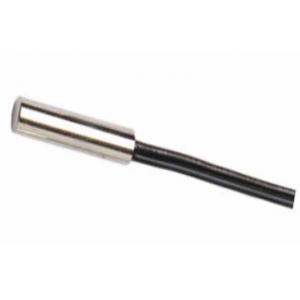

Add to Cart
Quick Detail:
Copper (brass) tube (pipe) case thermistor temperature sensor probe
assembly.
PVC insulated wire.
Moisture resistant.
Small, quick temperature response.
High stability under temperature shock.
Description:
NTC Thermistor can be assembled in housing in a variety of
configurations for temperature sensing, measurement, detection,
indicator, monitoring and control. Thermistor temperature sensor
probe assemblies can conveniently attach to or be an integral part
of any system to monitor or control temperature.The choice of
assembly is dependent on the application. The primary factors which
determine the optimum configuration of a thermistor assembly are
the operating environment, mounting, time response and minimum
dissipation constant.
The two factors which do vary considerably with thermistor sensor
probe assembly design are time constant and dissipation constant.
The time constant will typically be of greater duration in
encapsulated thermistors. This is, of course, due to additional
mass surrounding the thermistor element; therefore, extending the
thermal transfer time. Dissipation constant will also be greater in
assemblies. The additional housing mass serves well as a heat sink.
Greater power is therefore required to induce self-heating. Both
time constant and dissipation constant will vary with the selected
thermistor and housing. Heat transfer properties of the housing,
thermistor location, mass and wire type determine these constants.
Applications for temperature sensing include air temperature
sensors, surface temperature sensors and immersion temperature
sensors. Housings for air temperature sensors are often simple,
inexpensive devices such as molded plastic shells, deep-drawn brass
or aluminum cylinders, or even stainless steel tubes. Surface
temperature sensors are designed to match the contour of the
surface to be sensed, whether it's flat, curved, or round. Mounting
holes or clips are often used to simplify installation of the
sensor. Immersion temperature sensors are designed so that the
sensing element will be surrounded by the medium to be sensed,
often times a liquid. The sensing portion will normally protrude
through a hole or orifice while a portion of the assembly will
remain outside the medium to allow for the signal to be read.
Immersion housings are usually threaded to allow them to be screwed
into a hole or opening. Immersion part requests to be liquid and
humidity prevention.
The material used for the housing will be dependent upon the
temperature range needed, response time, cost, and special
considerations such as UL, FDA or NSF requirements in food and/or
medical applications. Some of the materials available include
stainless steel, copper, plastic, teflon, brass, aluminum, epoxy
and heat shrinkable tubing.
The following are examples of some NTC thermistor temperatu
Applications:
Specifications:
Resistance @25C | Beta Value | Thermal time constant | Dissipation factor | Operating temperature |
10K ohm±1% | 3950K±1% | 5 MW/C | 10 sec | -30C~+105C |
Note: Alternative ratings on resistance, Beta value and cable length upon request.
Competitive Advantage:
